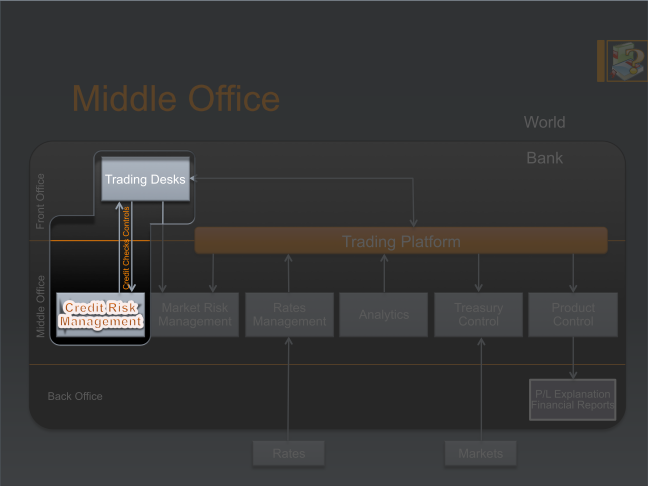Risk management is a critical function of Middle Office. Credit risk is the risk that somebody who owes you money may not be able or willing to honor their obligation. In other words, they may default on their credit obligation. This risk is managed in a bank using a variety of statistical tools.

When a bank issues you a credit card, it takes on credit risk that you may not pay up. You pay an insanely high interest rate on your outstanding balance precisely because of this credit risk. The risk is not secured. A mortgage or an auto loan, on the other hand, is secured by the equity of your property, and you pay a significantly lower interest because of the collateral.
The Middle Office team of Credit Risk Management (CRM) operates using the same two paradigms. Much the same way as you have a credit limit on your credit card or line of credit, each counterparty that the bank trades with has a certain credit limit based on their credit rating as published by credit rating agencies such as Moody’s or Standard & Poor. The problem with this mode of managing credit risk is that the bank has no way of knowing how much credit is loaded against a counterparty’s rating in other banks. Nor does it have a means of finding out how many credit cards you have. In Singapore, the regulatory authority, MAS, tries to minimize the risk of people going bust be requiring that their credit limit be twice their monthly salary. Bt they may get as many credit cards as they want from different banks against the same limit, effectively nullifying the good intention behind the requirement.
This overloading against credit rating is avoided when the risk is managed using collaterals. Much like you cannot take two mortgage loans on the same property (not without adequate equity, any way), counterparties in trading also cannot use the same collateral for multiple trades. Banks and counterparties typically use bonds as collaterals and physically exchange them during secured transactions.
Before the Front Office trader can enter into a trading agreement with a counterparty, they will need to get approval from the credit controllers who will assess exposures and check them against predefined limits. The exposure assessment uses techniques such as potential future exposure (PFE) based on a large number of simulations of potential future markets.
In addition to the risk of counterparties defaulting during the life time of a trade, CRM professionals worry about the potential for default during the delay in settlement — after the maturity of a trade (where the bank is in the money) and its settlement. This risk is aptly called the settlement risk.

